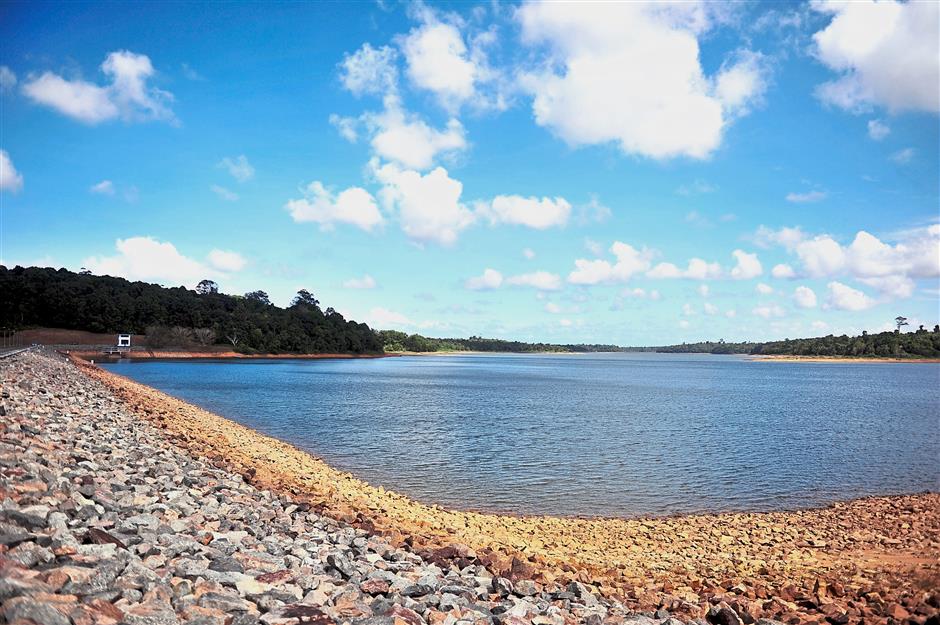Steering towards water security

KOTA TINGGI, 26 Feb -- Paras air di Empangan Sungai Lebam kini berada di paras kritikal ketika Pengerusi Jawatankuasa Perdagangan Antarabangsa, Pelaburan dan Utiliti, Jimmy Puah Wee Tse meninjau bacaan paras air di empangan tersebut hari ini.--fotoBERNAMA (2019) HAK CITA TERPELIHARA
WATER security, especially in Johor, has come into public attention again. A day after the National Water Services Commission (SPAN) released a statement urging Malaysians to conserve water, Sungai Lebam (pic), Upper Layang, Sembrong Barat and Lok Heng dams in Johor were reported to be approaching their respective critical levels. More worrying is that the dry weather is expected to last until the end of the north-east monsoon in March, according to the Meteorological Department’s forecast.
We have but one question to ask ourselves. Are we are heading towards a water crisis or a water-secure future in Johor?
Before we can answer this question, we should review the four major threats to water sources in Johor: climate change, development, pollution and saline intrusion.
Given the frequent reports of various dams reaching their critical levels due to drought each year, the impacts of climate change on water sources are obvious. Johor saw one of its worst dry spells in 2014. Congok Dam, the main water reservoir for the Mersing district, fell below its critical level in March 2014. Due to the El Nino phenomenon, the prolonged drought resulted in a five-month water rationing, causing residents of Mersing much inconvenience and misery. In August 2016, Congok Dam was completely dried up due to drought, causing another round of water rationing. This shows how ill-prepared we are to deal with climate change-induced water scarcity.
Although forests are a crucial source of water supply, balancing development and forest protection is no simple task. The struggle is best demonstrated by the recently exposed golf course and hotel development at Sungai Pulai forest reserve.
Sungai Pulai, which runs through a permanent reserve forest (PRF) gazetted under the National Forestry Act 1984 in 2006, contributes about 4% of raw water to Johor. Although its contribution pales in comparison to that of Sungai Johor’s 56%, Sungai Batu Pahat’s 15% or Sungai Muar’s 14%, Sungai Pulai is nonetheless indispensable, especially in times of emergency and given the predicted increase in water demand. The approved project seriously betrayed the state administrators’ lack of foresight or oversight.
Pollution is occasional but the consequences are immediate and severe. Sungai Johor is particularly vulnerable to pollution. In July 2016, a palm oil mill operated by a government-linked company was responsible for an ammonia spill in Sungai Johor, causing a water supply disruption that affected 120,000 users. In October 2017, Sungai Johor was again affected by ammonia pollution, this time from an illegal poultry farm that also makes fertiliser using chicken manure. In this case, 160,000 consumers were affected.
In January 2019, a licensed sand mining company operating in Sungai Johor was responsible for a 30-hour supply disruption.
Given the prevalence of pollution in Sungai Johor, the lack of strict enforcement and oversight is mind-boggling, to say the least.
Saline intrusion also occurs. As salty water cannot be processed by existing water treatment plants, saline intrusion can cause major water disruptions, especially in times of prolonged drought. In Johor, 80% of raw water come from rivers while the remaining 20% come from dams. Of the 19 rivers that provide raw water, Sungai Johor and Sungai Muar are particularly vulnerable to saline intrusion. Fortunately, the Johor state government has not been idle. The completed Johor River barrage project should solve the saline problem at Sungai Johor. There is, however, no update on the plan to construct a tidal barrage for Sungai Muar.
To combat these threats, the Johor state government came up with the Johor Water Resources Study Plan 2010-2060 in 2016. Two years after the implementation of the study plan, two flaws become apparent: absence of a functional state entity to lead the state’s sustainable water management, and lack of oversight and transparency.
Water supply-related agencies such as the Johor Water Regulatory Body, Ranhill SAJ Sdn Bhd and Department of Irrigation and Drainage are working in silos on the matter of sustainable water management. There is a lack of coordination with other agencies such as the State Economic Planning Unit, Forestry, Environment, and Agriculture departments, local land offices and even the Johor National Parks Corporation, whose jurisdiction and responsibilities affect water management in the state.
It is perhaps time to consider a reform so that the Johor Water Regulatory Body is empowered to lead the state’s water management effectively and overrule other agencies when there are overlapping jurisdictions over water issues.
The lack of oversight and transparency is more serious. How did the illegal poultry farm, which had twice polluted Sungai Johor, continue to operate until the incident in 2017? Why was the sand mining licence issued, despite the obvious impacts on Sungai Johor? How did the golf course and hotel development at Sungai Pulai forest reserve get approved?
Perhaps the involvement of watchdog NGOs and greater public participation, especially mandatory public hearings, can provide the much needed oversight when it comes to any development project or economic activity that will potentially affect the state’s water sources. A water crisis in Johor has been looming on the horizon over the past 10 years. Although various steps have been taken to address the problem, strong political will to reform is the key to steering the state towards a water-secure future.
SEN TANP
Melaka
Comments
Post a Comment